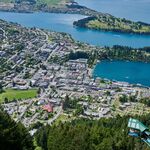Assertion that the stops are placed too close together. Looking at Google Maps measurements, the only stops I see that are not reasonably spaced out are Kennedy - Ionview and Warden - Hakimi Lebovic. All of the other inter-stop segments average half a kilometre between stops (the average stop spacing on the Danforth line), with some extremes such as Victoria Park - Sloane and Sloane - Wynford being almost 1 km apart. Just how far apart do you expect the stops to be?
The Bloor-Danforth Line should not be used as an example of good subway stop spacing, it's way too short. You want a good example of stop spacing done right? Look at Viva Blue in York Region, 1km stop spacing.
Moreover, your point could very well apply to all forms of suburban transit outside rush hour. As of right now (12:32 PM as I type this post), if I was starting from Kennedy and Eglinton and needed to get to Kipling Station, it would take me 51 minutes via line 2 or 46 minutes by car. Add in any potential disruptions, crowding, or getting off at the wrong end of the platform, and that time adds up. Then there are the personal, subjective feelings (which form the crux of most arguments about transit being competitive vs the car), such as colourful characters enriching the ride on the subway, or personal fears about COVID, or any number of other reasons. The further you're travelling, especially in less dense suburban areas, the less competitive transit becomes. That doesn't mean transit is worthless, but it means that there's always going to be something that prevents someone from taking transit. Rather than setting money on fire by building subways everywhere, we should seek to optimize transit to serve the people who will use it and be realistic that a goal of transit usage of 100% is not going to get us anywhere.
The assertion here is that you're starting at Kennedy and Eglinton, when in practice not many people will be starting there. You have to first get to Kennedy and Eglinton, and then take transit to where you need to go. Then after you reach Kipling, you're going to have to make a last mile connection there. Second, as I stated above the Bloor-Danforth line has frankly suboptimal stop spacing, and had it been build better could've been way faster. Finally, I actually love that you bring up Line 2's travel time because it allows me to make a side by side comparison. Line 6 is expected to have an end to end travel time of 35 mins, a little under that of Line 2, yet the line will be 10.6km instead of Line 2's 26.6km, slightly slower whilst being less than half of the length.
See my point above about extra stations. Furthermore, what you just described could easily be argued about a subway line, too. When I have to use line 2 for crosstown trips, I find it to be highly agitating to have to slow down and stop for passengers at holes in the wall like Chester, Greenwood, Donlands. So I guess to make it more competitive, we should nix all of these local stops of no consequence, so crosstown commuters don't have to suffer adding a few extra minutes to their commute.
It would be worth it I think. In an ideal world we would have a 4 track subway like New York, but the best option for now might be to say reactivate the midtown corridor and run that as an express route. It's unfortunately too late to change the design of Line 2 now.
Three issues with this argument.
1. The urban area of Prague is no more relevant to the discussion than the urban area of Toronto is. The Eglinton Crosstown is not going to be used, in any large capacity, by commuters from Hamilton, or Peel, or Halton, or York, or Durham - it is not GO Transit - so their existence is completely irrelevant to the equation. It is being used predominantly by passengers within Toronto.
Completely untrue, especially in the context of Peel, Durham, and York. GO is an extremely radial service, perfect for if you're going to downtown Toronto, but not everyone wants to go to Downtown Toronto. Say you're going to Midtown Toronto and you live in Vaughan. A completely expected trip could be to take the Barrie Line down to Caledonia, then transfer to Line 5 and head east. If you live in Mississauga and you want to head to Midtown or North York, we have MiTransitway -> Line 5 -> Line 1. This is the value of a crosstown route, there are actually many trips and journeys across the region that can be opened up, especially a corridor like Eglinton that connects so many different destinations and interchanges with so many other lines, and we blew it on an extremely fancy streetcar.
2. Just because Prague isn't as big as Toronto doesn't mean that lessons can't be learned from their transit. Any idea to the contrary is typical Torontonian exceptionalism. And if Prague is not to your liking, perhaps Belgrade, Bucharest, or Vienna would be. And FYI, as a point of comparison, Prague's longest tram line, the 10, is 22.29 km long and a single direction trip on it takes 68 minutes. And they have stupid car drivers and careless J-walkers, too.
There are 2 major differences between all of these cities and Toronto. First is land use, Toronto is far more sprawly and filled with car oriented suburbs. Second and most importantly, all these cities are building a massive amount of metros, the tram network in these cities effectively function as connecting tissues. The best use cases for on street trams are generally for A) As a feeder route to a larger rapid transit service, or B) As a local route in a downtown core. If we take a look at some old Transit City plans, we can actually see strong examples of these. The Finch West LRT, even though I blasted it's speed earlier, is a line that really doesn't punch above it's weight. It's a relatively short line that serves a specific area of Toronto. It connects to Line 1 in the east, and in the future will connect to the Kitchener Line in the West, as well as possibly the Bolton Line in the middle. It's not extremely long, so it's not really expected for people to travel end to end on it, it's a purely local service. Or how about the Scarborough Malvern LRT? Serves Central Scarborough with the idea being that it will connect people locals to subway and regional rail lines. The Eglinton Line is a massive straight line that costs almost as much a subway already, and is in a prime position for a longer distance crosstown route. Any european planner would look at it and tell you that it should probably be a subway line.
3. Most European cities, including Prague, are not laid out in a grid layout, so the distance end to end isn't much of a gotcha. Their streets, and therefore their transit routes, are winding. Moscow is one of the largest, if not the largest cities in Europe by area (2561 sq km) but when measured east-west is only 39 km across.
And Moscow is like the capital of building subways outside of China. In fact, Moscow is like a perfect case study for how to choose whether something should be a streetcar or a subway.
No, but the costs of building and maintaining such a thing are still much higher than regular median based rights-of-way, a point I have brought up repeatedly and which you continuously fail to address.
Because it doesn't really matter. We are already spending so much money on the tunneled section, the amount of money you'd spend on an elevated guideway in the middle of a stroad will be peanuts. Plus by building it as a metro, there are a ton of cost savings that you can find. Full automation means you spend far less on drivers. High Floor vehicles are generally quite a bit cheaper to maintain than Low Floor vehicles. If you fully automate a line, you can run at significantly higher frequencies which mean that all of these underground stations we built could be significantly smaller whilst offering a similar capacity if capacity really isn't an issue. As a reminder, the Canada Line in Vancouver that runs 40m trains has a higher ultimate capacity than the Eglinton Line at 3 car trains with 90m platforms.
End of story? So, what, just like that you can shut down an argument because of your own personal feelings toward LRT? Why exactly shouldn't anything grade separated be an LRT? So that we can have more lines like the underused Line 4 criss crossing the city?
The whole point of LRT is that it's flexible in where it can run, it can be on street or whatever. This is especially true for Low Floor vehicles. If we have a fully grade separated LRT, there are quite literally no benefits to using LRT technology, and you're stuck hurting with the downsides. Less capacity per m^2, and if you're using low floor vehicles you're now hit with longer dwell times, worse accessibility, and more expensive maintenance.
Also "that you can shut down an argument because of your own personal feelings toward LRT? " is a strawman. Nobody asked you to use your psychic powers to guess my motivations.




